1967 Chevelle SS396
[ 1964 ] | [ 1965 ] | [ 1966 ] | [ 1967 ] | [ 1968 ] | [ 1969 ] | [ 1970 ] | [ 1971 ] | [ 1972 ]
Any comments/corrections/additions please send them to me and be sure to specify which year.
The 1967 Chevelle SS396 was a separate series from the 300, 300 Deluxe & Malibu series and can be readily identified by both the Fisher Body Number plate (a.k.a. trim tag, cowl tag, etc.) and the Vehicle Identification plate (VIN).
The 1967 SS396 was available in both sport coupe (17) and convertible (67) models and the 396 cid Mark-IV engine was the base engine. The Fisher Body style numbers 13817 & 13867 and VINs beginning with 13817 & 13867 will note an SS396. As with all years of Super Sports, the VIN only depicts the base engine and does not indicate any optional engine. The base 396 engine was the (L35) 325hp engine with two optional 396 engines, a L34 350hp version and a L78 375hp version.
Although the El Camino could be ordered with any 396 engine, there are no SS396 1967 El Caminos; no SS396 badging, no Super Sport hood and no SS396 rocker panel moldings. A 396-optioned El Camino would have the 396 Turbo-Jet flags on the front fender however. The dash also retained the appropriate (13480 or 13680) upper dash strip and not the black crinkle-finish of the SS396
Contrary to popular belief bucket seats, gauges, and 4-speeds were not standard equipment. A front bench seat, no gauges (except speedometer, clock, and fuel gauge), and a 3-speed heavy duty floor shifted transmission were standard with the SS396.
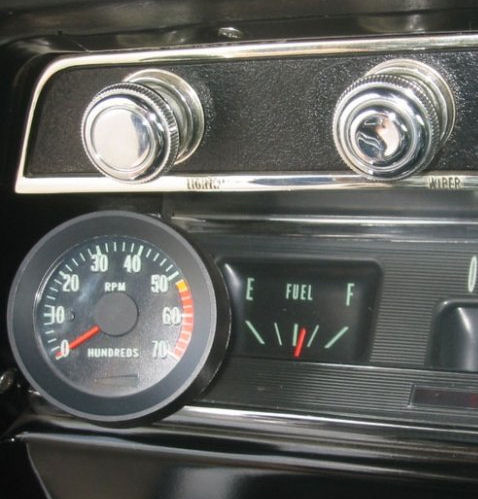
RPO U14 Special Instrumentation was optional on all V8 Malibu and SS396
Chevelle sport coupes, convertibles, and El Caminos and was no longer
available with the L6 engine. This option included tachometer, mechanical
oil pressure gauge, amp gauge, and water temperature gauge. The
tachometer could be ordered without the gauges under RPO U16 on any
V8 Chevelle series.
Two versions were available in the SS396 series, a 0-7000 RPM range with the redline at 5400 for both the base 396/325hp and the optional L34 396/350hp and a 0-7000 RPM range with the redline at 6000 for the L78 396/375hp engine. A third 0-7000 RPM range with the redline at 5000 could be ordered with any 283 or 327 engine. The L79 327/325 hp engine got the same redline (6000) as the L78.
Distinctive blacked out grille, Super Sport trim, a special SS396 hood with faux twin scoops, SS396 emblems on the grille and rear cove, Super Sport script on the rear quarter panels, and ribbed rocker panel moldings.

Note special SS396 hood with twin faux scoops, blacked-out grille with
SS396 emblem, blacked-out headlamp bezels, and blacked-put grille extensions.
Also note the two horizontal bright bars left in the grille, headlamp
bezels, and grille extensions as well as the grille cutouts at either
end next to the headlamp bezels. The 300, 300 Deluxe, and Malibu grilles
were also blacked-out but had more bright horizontal bars and the two
ends next to the headlamp bezels were filled in as noted on the Malibu
below as well as a different grille emblem.
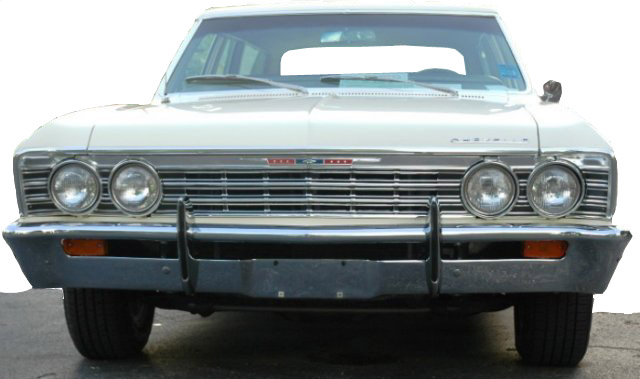
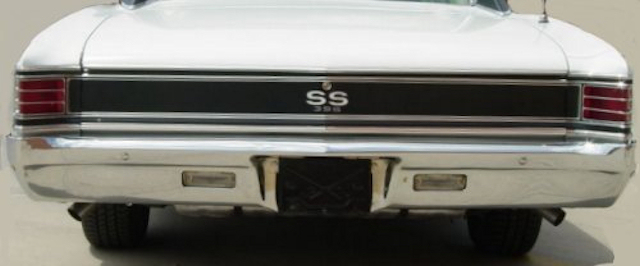
Unlike the controversy over the blacked-out rear cove on 1966 SS396
Chevelles, all 1967 SS396 Chevelles had this feature. The SS396 emblem
is centered in the rear cove.
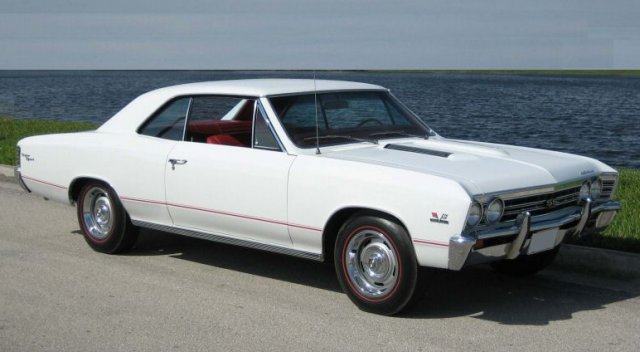
A ribbed rocker molding remained but the piece behind the fender well
was eliminated. The SS396 Turbo-Jet flags remained on the front fender
but the Super Sport script on the rear quarter panels was now split
on two lines instead of only one. Also new for 1967 were disc
brakes, although not limited to the SS396 series, requiring the rally
wheels shown here. The side stripes shown were standard fare for the
SS396. Many owners removed these vinyl stripes soon after taking delivery
or when they began to loosen and peel.
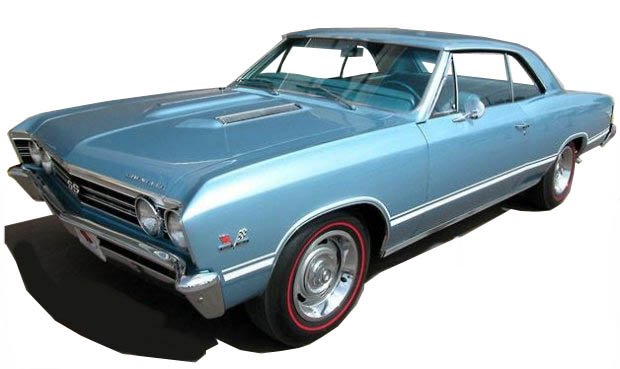
Optional on the SS396 were the D96 sport stripes that included a larger
lower stripe and stripes over the wheel wells.
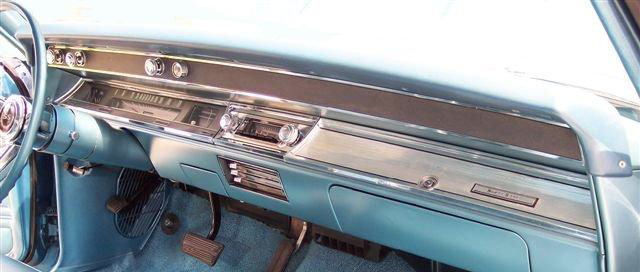
The SS396 dash received a black crinkle-finish dash strip and a Super
Sport emblem on the bezel above the glove box.
It should be noted that Canada produced a Malibu SS in 1967. This was a standard 135/136xx Malibu with a special package called The Sports Option. This Malibu SS continued to use the Malibu SS quarter panel trim from the 1965 Malibu SS but could be ordered with any available engine. It wasn't until January that the Canadian market saw a true SS396. See The Obscure Malibu SS of 1966/67 for more specifics on this Canadian option.
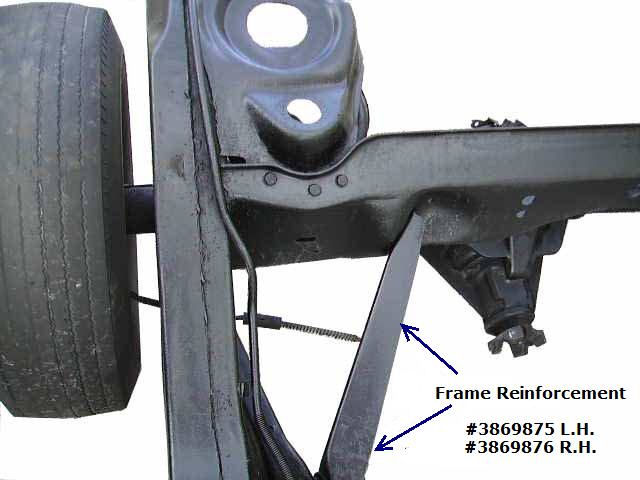
All SS396 Chevelles came with a 12-bolt rear end but Positraction was
still an option; an open rear end was standard. However, a 12-bolt rear
end, as well as Positraction, was available on non-SS396 Chevelles as
well so the presence of a 12-bolt (with or without Positraction) is
not an indication of a 1967 SS396 Chevelle. All SS396 Chevelles also
came with rear frame reinforcements but could easily be added to any
Malibu coupe or convertible.


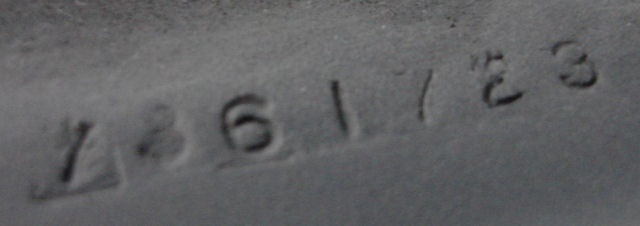
Found along the inner lip of the rear quarter panel, not actually a partial VIN but believed to be associated with the series/model ID due to differences between the Malibu and SS396 rear quarter panel piercing for emblem placement. This stamped number is located on the right rear quarter panel where the trunk lid meets the body next to the weather stripping material. While both 136xxxx stampings have been found on SS and non-SS Chevelles and 138xxxx stampings have been found on SS and non-SS Chevelles, those cases are rare and could be attributed to many things such as panel replacement from another Chevelle. The series/model identification is followed by another 2-digit number. These two digits indicate the calendar week the panel was stamped. (Courtesy Jeff Helms) Note in the top example these numbers were not always placed in the stamping die correctly; the "4" and the "2" are upside down.
Caveat: Numerous original cars have been reported with the 'wrong' 136xx vs 138xx stamping. Whether this was due to poor quality control, inattention by the workers, or panels stacked in the wrong location is not known.


Both the Malibu and SS396 got a black-out treatment on the area just
above the rear cove in the trunk. This was done to continue the black
of the tail lamp housings.
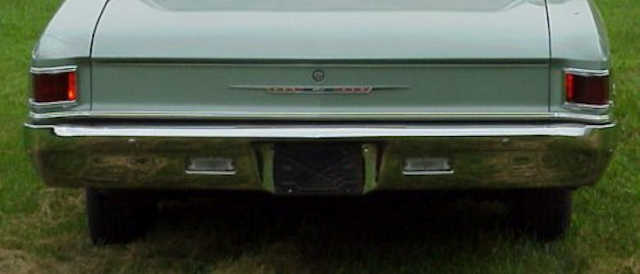
Note the 300 series and the 300 Deluxe series did not get this black-out
treatment since the tail lamp housings were much different.

Want more in-depth information on 1966/1967 Chevelles? Try my 1966/1967 Chevelle
Reference CD.
FREE DEMO CD DOWNLOAD!


 Home
Home Decode
Decode Tech
Tech Tools
Tools Dale's Coins/CDs
Dale's Coins/CDs Contact
Contact Chevelle
of the Month
Chevelle
of the Month Things
For Sale
Things
For Sale Custom
Stickers
Custom
Stickers

